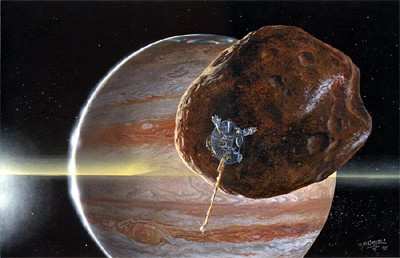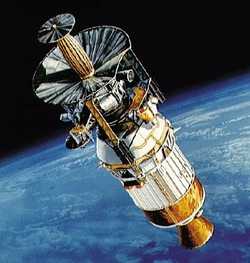Say, Where Did THAT Come From?
Scientists studying data from NASA's Galileo spacecraft have
found that Jupiter's moon Amalthea is a pile of icy rubble less
dense than water. Scientists expected moons closer to the planet to
be rocky and not icy. The finding shakes up long-held theories of
how moons form around giant planets.

"I was expecting a body made up mostly of rock. An icy component
in a body orbiting so close to Jupiter was a surprise," said Dr.
John D. Anderson, an astronomer at NASA’s Jet Propulsion
Laboratory, Pasadena, CA. Anderson is lead author of a paper on the
findings that appears in the current issue of the journal
Science.
"This gives us important information on how Jupiter formed, and
by implication, how the solar system formed," Anderson said.
Current models imply that temperatures were high at Amalthea's
current position when Jupiter’s moons formed, but this is
inconsistent with Amalthea being icy. The findings suggest that
Amalthea formed in a colder environment. One possibility is that it
formed later than the major moons. Another is that the moon formed
farther from Jupiter, either beyond the orbit of Jupiter's moon
Europa or in the solar nebula at or beyond Jupiter's position. It
would have then been transported or captured in its current orbit
around Jupiter. Either of these explanations challenges models of
moon formation around giant planets.
 "Amalthea is throwing us a curve
ball," said Dr. Torrence Johnson, co-author and project scientist
for the Galileo mission at JPL. "Its density is well below that of
water ice, and even with substantial porosity, Amalthea probably
contains a lot of water ice, as well as rock." Analysis of density,
volume, shape and internal gravitational stresses lead the
scientists to conclude that Amalthea is not only porous with
internal empty spaces but also contains substantial water ice.
"Amalthea is throwing us a curve
ball," said Dr. Torrence Johnson, co-author and project scientist
for the Galileo mission at JPL. "Its density is well below that of
water ice, and even with substantial porosity, Amalthea probably
contains a lot of water ice, as well as rock." Analysis of density,
volume, shape and internal gravitational stresses lead the
scientists to conclude that Amalthea is not only porous with
internal empty spaces but also contains substantial water ice.
One model for the formation of Jupiter's moons suggests that
moons closer to the planet would be made of denser material than
those farther out. That is based on a theory that early Jupiter,
like a weaker version of the early Sun, would have emitted enough
heat to prevent volatile, low-density material from condensing and
being incorporated into the closer moons. Jupiter's four largest
moons fit this model, with the innermost of them, Io, also the
densest, made mainly of rock and iron.
Amalthea is a small red-tinted moon that measures about 168
miles in length and half that in width. It orbits about 181,000
kilometers (112,468 miles) from Jupiter, considerably closer than
the Moon orbits Earth. Galileo passed within about 99 miles of
Amalthea on Nov. 5, 2002. Galileo's flyby of Amalthea brought the
spacecraft closer to Jupiter than at any other time since it began
orbiting the giant planet on Dec. 7, 1995. After more than 30 close
encounters with Jupiter's four largest moons, the Amalthea flyby
was the last moon flyby for Galileo.
The Galileo spacecraft's 14-year odyssey came to an end on Sept.
21, 2003. JPL, a division of the California Institute of Technology
in Pasadena, managed the Galileo mission for NASA.
 ANN's Daily Aero-Term (04.20.24): Light Gun
ANN's Daily Aero-Term (04.20.24): Light Gun Aero-News: Quote of the Day (04.20.24)
Aero-News: Quote of the Day (04.20.24) ANN's Daily Aero-Linx (04.21.24)
ANN's Daily Aero-Linx (04.21.24) Aero-News: Quote of the Day (04.21.24)
Aero-News: Quote of the Day (04.21.24) ANN's Daily Aero-Term (04.21.24): Aircraft Conflict
ANN's Daily Aero-Term (04.21.24): Aircraft Conflict




